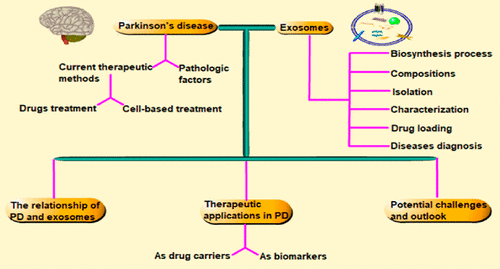当前位置:
X-MOL 学术
›
Mol. Pharmaceutics
›
论文详情
Our official English website, www.x-mol.net, welcomes your
feedback! (Note: you will need to create a separate account there.)
Potential Therapeutic Applications and Developments of Exosomes in Parkinson's Disease.
Molecular Pharmaceutics ( IF 4.5 ) Pub Date : 2020-03-31 , DOI: 10.1021/acs.molpharmaceut.0c00195 Siqi Luo 1 , Libo Du 2 , Yan Cui 1
Molecular Pharmaceutics ( IF 4.5 ) Pub Date : 2020-03-31 , DOI: 10.1021/acs.molpharmaceut.0c00195 Siqi Luo 1 , Libo Du 2 , Yan Cui 1
Affiliation

|
Parkinson's disease (PD) is the second most common neurodegenerative disease around the world. Current treatments alleviate the symptoms through the administration of drugs, including dopamine precursors, dopamine metabolism inhibitors, and activated dopamine agonists, but they cannot prevent the ongoing dopaminergic damage. One of the pivotal factors is the poor drug transport efficiency of crossing the blood-brain barrier, while studies reveal that exosomes are endogenous vesicles that are useful for drug delivery and disease diagnosis. As drug carriers, exosomes can not only deliver effective therapeutic drugs but also conquer difficulties such as biocompatibility, blood-brain barrier penetrability, metabolic stability, and target specificity. Exosomes have been successfully loaded with catalase, dopamine, catalase mRNA, and small interfering RNA for PD treatment and shown significant therapeutic effects. As diagnostic indicators (biomarkers), exosomes are more sensitive and reliable. They can reflect the pathological conditions and monitor disease progression. Exosomes from cerebrospinal fluid, plasma, serum, saliva, and urine are valuable biomarkers for PD diagnosis. This review mainly illuminates the association between exosomes and PD, sums up the therapeutic and diagnostic applications of exosomes in PD, and raises some critical remaining questions on the field. It is proposed that future investigations could be dedicated to exploiting a standard procedure to prepare large-scale exosomal carriers with high loading efficiency and new components of exosomes as biomarkers (mRNA; receptors), for better therapeutic and diagnostic options of PD.
中文翻译:

外泌体在帕金森氏病中的潜在治疗应用和发展。
帕金森氏病(PD)是世界上第二常见的神经退行性疾病。当前的治疗通过施用药物来减轻症状,所述药物包括多巴胺前体,多巴胺代谢抑制剂和活化的多巴胺激动剂,但是它们不能防止正在进行的多巴胺能损害。关键因素之一是穿越血脑屏障的药物转运效率差,而研究表明外泌体是内源性囊泡,可用于药物输送和疾病诊断。作为药物载体,外泌体不仅可以递送有效的治疗药物,而且可以克服诸如生物相容性,血脑屏障穿透性,代谢稳定性和靶标特异性等难题。外泌体已成功加载过氧化氢酶,多巴胺,过氧化氢酶mRNA,以及用于PD治疗的小干扰RNA,并显示出显着的治疗效果。作为诊断指标(生物标志物),外来体更加敏感和可靠。它们可以反映病理状况并监测疾病进展。脑脊液,血浆,血清,唾液和尿液中的外泌体是诊断PD的重要生物标志物。这篇综述主要阐明了外泌体和PD之间的联系,总结了外泌体在PD中的治疗和诊断应用,并提出了一些尚待解决的关键问题。建议未来的研究可以致力于开发一种标准程序,以制备具有高负载效率的大规模外泌体载体,并利用外泌体的新成分作为生物标记物(mRNA;受体),以更好地治疗PD。
更新日期:2020-03-31
中文翻译:

外泌体在帕金森氏病中的潜在治疗应用和发展。
帕金森氏病(PD)是世界上第二常见的神经退行性疾病。当前的治疗通过施用药物来减轻症状,所述药物包括多巴胺前体,多巴胺代谢抑制剂和活化的多巴胺激动剂,但是它们不能防止正在进行的多巴胺能损害。关键因素之一是穿越血脑屏障的药物转运效率差,而研究表明外泌体是内源性囊泡,可用于药物输送和疾病诊断。作为药物载体,外泌体不仅可以递送有效的治疗药物,而且可以克服诸如生物相容性,血脑屏障穿透性,代谢稳定性和靶标特异性等难题。外泌体已成功加载过氧化氢酶,多巴胺,过氧化氢酶mRNA,以及用于PD治疗的小干扰RNA,并显示出显着的治疗效果。作为诊断指标(生物标志物),外来体更加敏感和可靠。它们可以反映病理状况并监测疾病进展。脑脊液,血浆,血清,唾液和尿液中的外泌体是诊断PD的重要生物标志物。这篇综述主要阐明了外泌体和PD之间的联系,总结了外泌体在PD中的治疗和诊断应用,并提出了一些尚待解决的关键问题。建议未来的研究可以致力于开发一种标准程序,以制备具有高负载效率的大规模外泌体载体,并利用外泌体的新成分作为生物标记物(mRNA;受体),以更好地治疗PD。











































 京公网安备 11010802027423号
京公网安备 11010802027423号